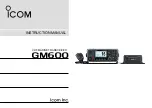
NSB–6
System Module
PAMS Technical Documentation
Page 45
Issue 1 06/2000
E
Nokia Mobile Phones Ltd.
Transmitter
Transmitter chain consists of final frequency IQ–modulator, dualband
power amplifier and a power control loop.
I– and Q–signals are generated by baseband also in COBBA–ASIC. After
post filtering (RC–network) they go into IQ–modulator in HAGAR. LO–sig-
nal for modulator is generated by VCO and is divided by 2 or by 4 de-
pending on system mode, EGSM/GSM1900. After modulator the TX–sig-
nal is amplified and buffered. There are separate outputs for both EGSM
and GSM1900. HAGAR TX output level is 5 dBm minimum.
Next TX signals are converted to single ended by discrete baluns. EGSM
and GSM1900 branches are compined at a diplexer. In EGSM branch
there is a SAW filter before diplexer to attenuate unwanted signals and
wideband noise from the Hagar IC.
The final amplification is realized with dualband power amplifier. It has
two 50 ohm inputs and two 50 ohm outputs. There are also separate gain
controls, which is controlled with a power control loop in HAGAR. PA is
able to produce over 2 W (4 dBm input level) in EGSM band and over 1
W (4 dBm input level) in GSM1900 band into 50 ohm output. Gain control
range is over 35 dB to get desired power levels and power ramping up
and down.
Harmonics generated by the nonlinear PA are filtered out with the diplexer
inside the antenna switch–module.
Power control circuitry consists of discrete power detector (common for
EGSM and GSM1900) and error amplifier in HAGAR. There is a direc-
tional coupler connected between PA output and antenna switch. It is a
dualband type and has input and outputs for both systems. Dir. coupler
takes a sample from the forward going power with certain ratio. This sig-
nal is rectified in a schottky–diode and it produces a DC–signal after filter-
ing.
This detected voltage is compared in the error–amplifier in HAGAR to
TXC–voltage, which is generated by DA–converter in COBBA. TXC has a
raised cosine form (cos
4
– function), which reduces switching transients,
when pulsing power up and down. Because dynamic range of the detec-
tor is not wide enough to control the power (actually RF output voltage)
over the whole range, there is a control named TXP to work under de-
tected levels. Burst is enabled and set to rise with TXP until the output
level is high enough, that feedback loop works. Loop controls the output
via the control pin in PA to the desired output level and burst has the wa-
veform of TXC–ramps. Because feedback loops could be unstable, this
loop is compensated with a dominating pole. This pole decreases gain on
higher frequencies to get phase margins high enough. Power control loop
in HAGAR has two outputs, one for both freq. bands.











































